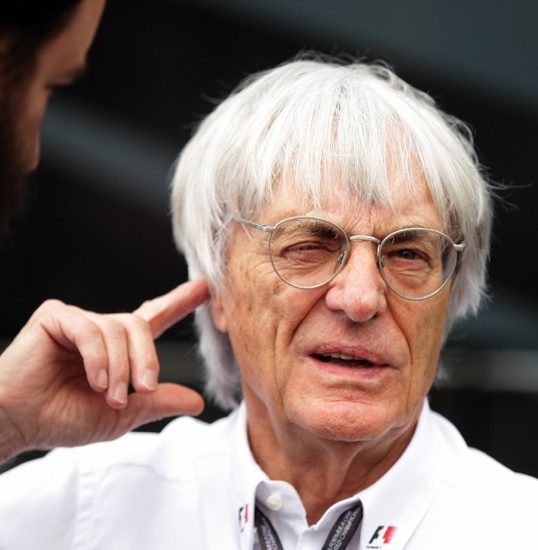The Australian Grand Prix was the first chance that the spectators had to see and hear the introduction of the new 2014 regulations in full. Pre-season testing beckoned the new exhaust notes in, but the real test would be with 22 of them sat on the grid waiting for the start lights to fade. There has been a divided opinion over the volume of the new engines, headlined by Bernie Ecclestone's regular complaints over the diminished noise from the V6 turbos.
 |
| Bernie Ecclestone has certainly voiced his concern about the quieter sound from the 2014 F1 cars. |
The sound itself is experienced in 2 very different ways, in that the majority of fans will watch Formula 1 on TV but some 100,000 fill the grandstands at the circuit itself. The TV feed provided by FOM, and the distributing channels themselves are of course free to mix sound levels, volumes and feeds to create the final output. The result of this mixing over the high revving V8 years left a rather dull buzzing background throughout the race, something caused by the cars being audible for miles around. Therefore no matter which microphone was getting fed out, all cars around the circuit could be heard whether in the immediate area or not. Furthermore, the combination of naturally aspirated engines, seamless gear shifting, constant exhaust blowing and limited KERS harvesting meant that the note from the engine did not change greatly regardless of what it was currently doing.
 |
| I personally disliked the sound of the V8 on TV, only a slight pitch change to the engines whine was distinguishable. |
My own opinion regarding being at the circuit however can only be drawn from the one race I have been able to attend. I have seen historic Formula 1 cars raced in special events, but that isn't a fair comparison. Last year I went to the Hungarian Grand Prix for all 3 days and I hope to see more soon. I was expecting loud of course, remembering a 1999 Ferrari put through it's paces at Brands Hatch rattling through my ribcage before you could even see it. We were sat in the grandstand opposite the pitlane, and when the cars initially left the garages on Friday morning for their installation laps, I hadn't yet put my ear plugs in as I wanted to see if I could cope with the levels beforehand. I lasted until the first car (a Red Bull I think) blasted down the main straight on full chat for the first time, you just can't begin to describe the levels of noise produced. The ear plugs went in, and despite not able to hear the person next to me the cars were still coming through loud and clear, with the engine notes now more defined between the cars.
 |
| At the circuit you can clearly hear differences between the cars, something hidden from TV viewers. |
The V8 engines sounded worlds apart when watching at the circuit compared to the TV whine. Every gear change was complimented by pops and a harsh metallic sound and gears were thrown together at speed and in fractions of a second. Furthermore, you could hear specific differences between the engine manufacturers and the teams in how they utilised the exhaust gas over the rear of the car. The Red Bull's especially could be heard rasping more as the various systems ensured the supply of hot air was kept constant on and off throttle. I will agree with Ecclestone's view in that respect, hearing the cars at the circuit really did make me fall in love with the cars that little bit more.
 |
| The superiority of the Red Bull's exhaust gas use could be heard at the circuit in 2013. |
I was not at the Australian Grand Prix, and currently do not have plans (more specifically, the budget) to see a race in 2014, so I could not say personally what the new engines are like in the flesh. We have however heard a lot of the paddock personalities talking about them, mainly focused still on the volume of them. The new engines are now quiet enough not to need ear defenders, though that could still be classed as a matter of opinion. Having to wear them in Hungary did not affect the experience for me at all though, so it shouldn't make much difference. From the TV footage though, that definition of what is happening within the power unit is far clearer and a much nicer sound than last year. The harvesting of electrical energy under braking sounds futuristic, and the whine of the turbo spooling up at corner exit starts to point out clues in each of the drivers power delivery technique.
 |
| The Mercedes engine sounds the smoothest of the 2014 power units, reflected by the apparent ease at which the drivers can accelerate through corners. |
I intend to be at a Formula 1 race as soon as possible and I look forward to hearing the new power units live. I may find that the sound was better before, but where Ecclestone seems to think that will affect fans perception of attending races, I believe he has overlooked one very large factor about being at a Grand Prix - the atmosphere. The Hungarian Grand Prix is something of a home race for the Finnish fans who attend in their tens of thousands to cheer on Kimi Raikkonen. When he emerged from his pitstop in second position and ahead of the ever hated Sebastian Vettel, the place nearly erupted. When he emerged on the podium at the end, it did.
 |
| Raikkonen's second place was easily the most popular result of the day. No prizes for guessing what the least popular was... |







No comments:
Post a Comment